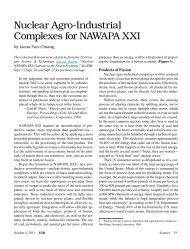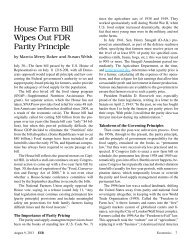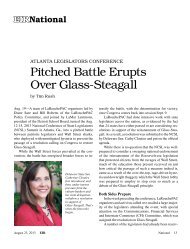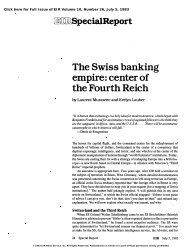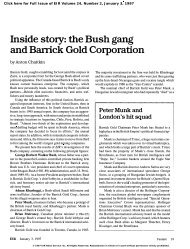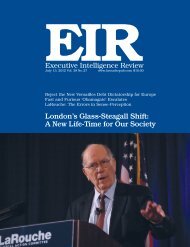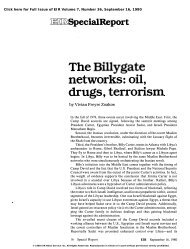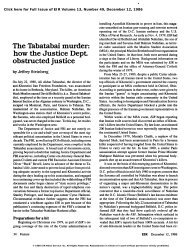View Full Issue - Executive Intelligence Review
View Full Issue - Executive Intelligence Review
View Full Issue - Executive Intelligence Review
Create successful ePaper yourself
Turn your PDF publications into a flip-book with our unique Google optimized e-Paper software.
International Credit by William Engdahl<br />
The real U.S. debt problem<br />
Companies have incurred a staggering amount of corporate<br />
debt, most alarmingly through the so-called leveraged buy-outs .<br />
Debt is a much-discussed issue these<br />
days in Washington and in the international<br />
financial media. But the real<br />
debt problem which is causing alarm<br />
and driving policy in Washington,<br />
New York, London, Tokyo, and Basel<br />
is not that of Mexico or Brazil. It is<br />
not even that of the embattled U.S.<br />
savings and loan banks. The real alarm<br />
is over the mushrooming U.S. internal<br />
debt.<br />
Now, debt is sometimes an elusive<br />
commodity. What is one man's debt<br />
can be another's credit. But in this<br />
case, the growth of U.S. debt, most of<br />
all private debt, is causing alarm bells<br />
to ring in more than one central bank<br />
headquarters . Here is a little indication<br />
of what they are alarmed about.<br />
According to the Federal Reserve,<br />
total U. S. debt is growing at a breathtaking<br />
rate. Debt per se is not so<br />
alarming as the rate of increase of debt<br />
in relation to a nation's ability to repay<br />
it from production of something real.<br />
According to the Fed, in December<br />
1984, total U.S. debt was an eyebrowraising<br />
$5 .9 trillion. That figure included<br />
$1.4 trillion of federal debt.<br />
By August 1988, the latest available<br />
data period, the total U.S. debt<br />
figure had ballooned to more than $8.7<br />
trillion. This represents an increase of<br />
a whopping 48% in three and a half<br />
years . In addition, the rate of increase<br />
of this indebtedness continued, unabated,<br />
after the warnings of the "Black<br />
Monday" October 1987 stock market<br />
crash.<br />
The much-publicized increase in<br />
the U.S. national debt incurred under<br />
the Reagan years , rising to some $2.5<br />
trillion by the end of 1988, is one com-<br />
EIR January 20, 1989<br />
ponent of this problem to be sure. But<br />
the increase in U.S. private sector indebtedness<br />
is the far larger one. Here,<br />
in addition to bank debt, and mortgage<br />
and private consumer debt, U.S. companies<br />
have incurred a staggering<br />
amount of corporate debt, most alarmingly<br />
through the wave of so-called<br />
leveraged buy-outs (LBOs).<br />
Under U.S. financial market deregulation,<br />
Reagan-era regulatory<br />
permissiveness and tax law, it is enormously<br />
profitable for a group of predators,<br />
"investors," to borrow up to 90%<br />
of the cost of taking over a company<br />
through buying all its available stock<br />
shares, in hopes the value of the target<br />
will rise. That borrowing is typically<br />
collateralized by the assets of the victim<br />
company, hence the term "leveraged."<br />
Because of tax laws which<br />
make interest on such debt tax -deductible,<br />
the "investors" often tum<br />
short-term profits of 100% or more.<br />
Ironically, Black Monday's background<br />
was the misconceived attempt<br />
by big New York banks like Citibank,<br />
then-Fed chief Volcker, and the Reagan<br />
administration to "solve" the 1982<br />
Ibero-American debt crisis for the U.S.<br />
banks by triggering the "Reagan recovery"<br />
consumer boom. This led directly<br />
into Oct. 19, 1987. Then, as an<br />
attempt to recover trading profits lost<br />
after Black Monday, Wall Street investment<br />
houses and large banks<br />
rushed pell-mell into LBOs at an alltime<br />
record pace. One Wall Street estimate<br />
is that the volume of all U.S.<br />
mergers and acquisitions, LBOs included,<br />
hit an all-time record well<br />
above the record in 1986 of $205 billion.<br />
LBOs were a major part of this.<br />
Major banks, insurance companies and<br />
pension funds have all gone into the<br />
LBO boom in recent months, joining<br />
Wall Street houses like KKR, Drexel<br />
Burnham, and others.<br />
Already in September 1987, a<br />
Congressional Research Service re-<br />
• port to Congress on LBOs warned that<br />
"debt is increasing at an unprecedented<br />
pace for the postwar period, and<br />
that debt is mounting more rapidly than<br />
nominal gross national product-an<br />
unusual phenomenon." Additionally,<br />
that study warned, "the composition<br />
of debt outstanding has shifted markedly<br />
towards short-term borrowingmainly<br />
in the form of floating-rate financing-while<br />
long-term borrowing<br />
by the private sector has diminished<br />
significantly in importance." This report<br />
was actually written some weeks<br />
before the October 1987 market crash.<br />
It is even more alarmingly true in January<br />
1989 than when it was submitted.<br />
The problem is that U. S. interest<br />
rates for precisely short-term borrowing<br />
are rising rapidly. Since last spring,<br />
rates have gone up more than 2% to<br />
the highest levels since the crash, with<br />
no limit in sight. Fed chief Alan<br />
Greenspan "is clearly walking a tightrope<br />
trying to cool the LBO frenzy<br />
before it threatens the entire edifice,<br />
while also trying to avoid precipitating<br />
full-scale recession from higher<br />
rates," a well-placed City of London<br />
banker stressed to me. As Anatole Kaletsky<br />
of the London Financial Times<br />
noted recently, "Unfortunately, leverage<br />
has an appalling way of making<br />
losses spin out of control on the way<br />
down just as it sensationally magnifies<br />
rewards on the way up." Little wonder<br />
that reports of problems for KKR of<br />
New York in raising part of the staggering<br />
$25 billion it committed to the<br />
LBO takeover ofRJR Nabisco already<br />
have tremors running through London,<br />
New York, and Tokyo.<br />
Economics 19






